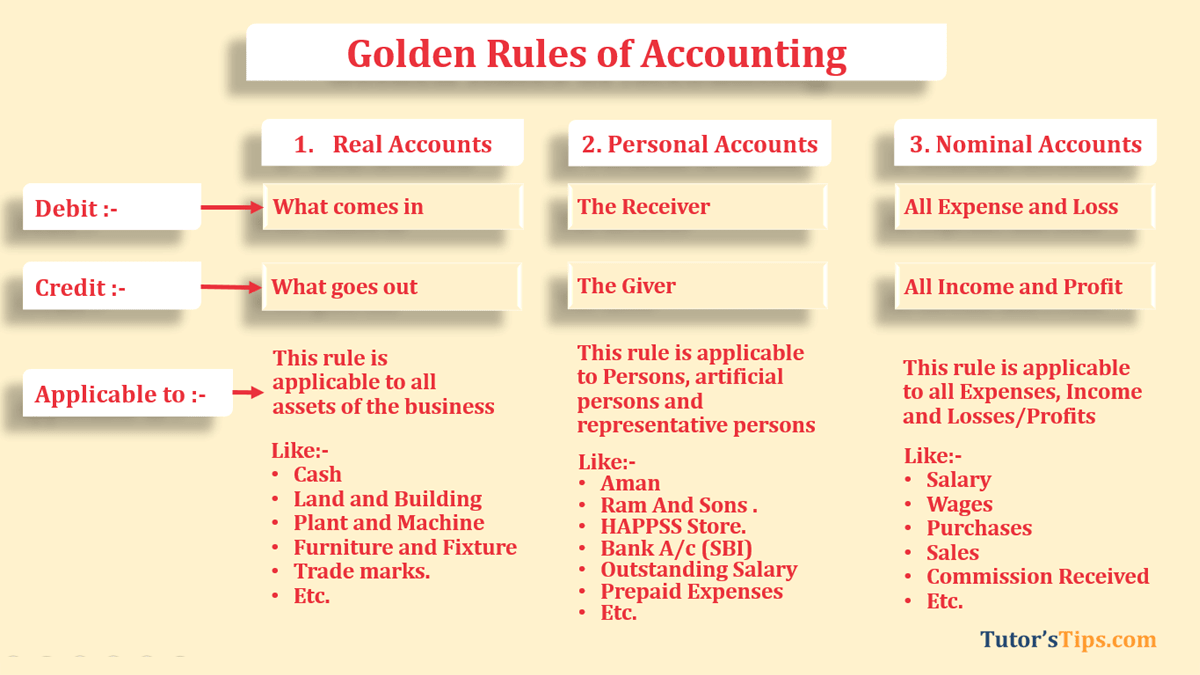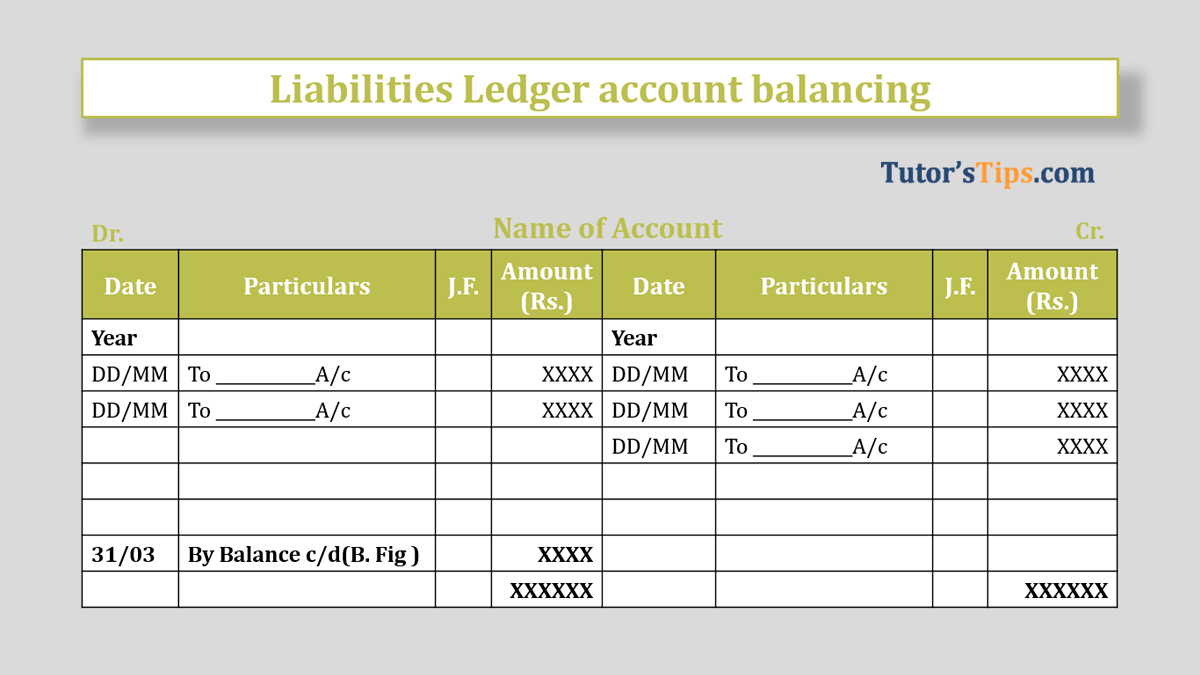Every business (for-profit or non-profit organization) has to furnish a record of its financial transactions in the form of accounting books to the interested parties (The owner, investors, government departments, etc.). The golden rules of accounting provide standardized regulation for the accountant to record all financial business transactions to prepare the accounting books, So that’s why it is essential to learn.
What are the Golden Rules of Accounting?
The golden rules of Accounting provide the basis to record all day-to-day financial business transactions in the Journal Day Book. These rules will provide a minimum of two accounts from a single business transaction one is debit and another is credit which is required to record the journal entry in the journal daybook. So you can say that these rules are the foundation of the Double-entry system. To understand the Golden Rules of Accounts, first, we have to know the types of accounts as per the Golden Rules of Accounts because rules are applied to the transaction based on the type of accounts included in the transaction.
These rules are also known as traditional rules of accounting or traditional approaches to accounting. Now modern rules of accounting or modern approaches to accounting are also invented which have five types of rules and we have explained them in the next article.
Watch our YouTube video of the Golden Rules of Accounting, to understand the concept behind the Golden Rules deeply.
Types of Accounts as per the Golden Rules of Accounting
The golden rules of accounting are implemented on all ledger accounts i.e. assets, liabilities, incomes, gains, expenses, and losses which are involved in business transactions, So according to the golden rules of accounting the ledger accounts are classified into three types. These are explained with the examples as following: –
1. Real Account
As per the golden rules of accounting, real accounts include those related to the business enterprise’s assets. So, This rule applies to the following business transactions which are related to the assets accounts: –
- Purchase/Creation of assets,
- Sale of assets,
- Depreciation charged on the assets, and
- Dispose of an asset.
Now to apply this rule, we have to know the meaning of assets.
What is an asset?
The asset is that valuable thing or property that the business or individual owns and gets the benefits from it in the future or used in generating income. In other words, The tangible objects and the intangible rights owned by the business enterprises are known as an asset.`
The example of assets on which the Real Account is applicable:-
- Land and Building,
- Furniture and fixture
- Plant and Machine
- Vehicles
- Cash
- Trademarks
- Copyright
The list is very long, you will know all of them after completing this full tutorial.
Advertisement-X
“Click here to check out the types of assets.”
2. Personal Account
As per the golden rules of accounting, personal accounts include those accounts that are related to all types of persons i.e. natural persons, artificial persons, and representative persons. The three types of persons are explained as follows: –
1. Natural Persons: – The accounts which are related to human beings are known as natural persons. For example Amanpreet, Jazz, Pawan Kumar, Vijay, and Amir Khan. Etc.
2. Artificial persons: – The accounts which do not have any physical existence and created by-laws are known as Artificial persons. For example, Any business account may be a firm, company, bank, or institution.
3. Representative persons: – Those accounts which represent the person or group of persons are known as Representative persons. For example, Outstanding Salary, Prepaid Expenses, Accrued Income, Pre-received Income, Etc.
3. Nominal Account
As per the golden rules of accounting, Nominal accounts include those accounts that are related to all expenses/losses and incomes/gains.
Example of all accounts on which the Nominal Account is applicable:-
- Expense Accounts: –Salary, Wages, Purchases, Electricity bill, Telephone, and mobile Rent, Transportation charges, Rent Paid, Etc.
- Income Accounts: – Sales, Commission Received, Rent on sublet building received, Etc.
- Loss Accounts: – Loss on sale of an asset, Loss by Theft, Loss by fire, loss by an accident, Etc.
- Profit Accounts: – Profit on the sale of an asset, Etc.
Click here to check the meaning of Expenses, Income, and Losses/Profits.
The 3 Golden Rules of Accounting
|
Type of Accounts |
The Golden Rules of Accounting |
| 1. Real Account | Debit: What comes in Credit: What goes out |
| 2. Personal Account | Debit:- The Receiver Credit: The Giver |
| 3. Nominal Account | Debit:- All Expenses and Losses Credit:- All income and gains |
1. Real Rule/Account
As I have explained above in the types of accounts the Real rule is only applicable to the asset’s accounts. It means as per the statement of the Real rule, debit the asset’s account when an asset comes into the business and credit the asset’s account when an asset goes out.
So, you have to debit the asset’s account when a business purchase or create the assets and credit the asset’s account when a business sells or disposes the assets.
Advertisement-X
2. Personal Rule/Account
As per the types of accounts, the Personal Rule applies all types of personal accounts. It means as per the statement of the Personal Rule, Debit the person’s account (it may be a natural, artificial, or representative person) when a person receives something from our business (it may be goods or services) and Credit the person’s account when a person gives something to our business.
3. Nominal Rule/Account
As per the types of accounts, the Nominal Rule applies to expenses/losses and income/gains accounts. It means as per the statement of the Nominal Rule, Debit the Expenses/losses account when a business incurred some expense or loss and Credit the Income/gain account when a business earns income or gets gains.
How to apply the Golden Rules of Accounting to any transaction in an easy way?
After understanding all three types of accounts and the rules of accounting a question raised is how we can apply it to any transaction. We have explained these all rules individually with examples as follows: –
1. Real Accounts
We’ll show you, How you can apply the Golden Rules of accounting step by step with the following example: –
Example No. 1: Purchase Furniture for Rs 10,000/-
| Steps | Purchase Furniture for Rs. 10,000/- | ||
| 1st | Scan and select affected Accounts (From the transaction) | Furniture | 10,000/- Cash |
| 2nd | Select What type of Accounts these are (separately) | Asset Account | Asset Account |
| 3rd | Select the rule which will be applied to these accounts | Real Account | Real Account |
| 4th | What will be the effect of this transaction on these accounts | Purchased | Payment made |
| 5th | Which condition of the golden rule is applied to these accounts | Comes in | Goes out |
| 6th | Now, In the end, you get the name of the Debit and the credit account. | Debit (What comes in) | Credit (What goes out) |
Journal entry for the above Example: –
From the above table, we got the names of the debit account and the credit account. So, now we have to write these gotten names into the standard format of the journal daybook as shown below: –
| Date | Particulars |
L.F. | Debit | Credit | |
| Furniture a/c | Dr. | 10,000 | |||
| To Cash a/c | 10,000 | ||||
| (Being Furniture purchased) | |||||
The above format is the standard format for Journal Entries in Accounting. if you want more explanation about it please visit the following link.
2. Personal Accounts
Example No. 1: – Purchase of Furniture For Rs. 10,000/- from Aman on Credit.
| Steps | Purchase Furniture for Rs. 10,000/- From Aman on Credit | ||
| 1st | Scan and select affected Accounts (From the transaction) | Furniture | Aman |
| 2nd | Select what type of Accounts these are (separately) | Asset Account | Person Account |
| 3rd | Select the rule which will be applied to these accounts | Real Account | Personal Account |
| 4th | What will be the effect of this transaction on these accounts | Purchased | Selling furniture |
| 5th | Which condition of the Golden Rule is applied to these accounts | Comes in | Giver |
| 6th | Now, in the end, you get the names of the Debit and the credit account. | Debit (What comes in) | Credit (The Giver) |
*Download image in PNG:-
Advertisement-X
Journal entry for the above Example
From the above table, we got the names of the debit account and the credit account. So, now we have to write these gotten names into the standard format of the journal daybook as shown below: –
| Date | Particulars |
L.F. | Debit | Credit | |
| Furniture a/c | Dr. | 10,000 | |||
| To Aman a/c | 10,000 | ||||
| (Being Furniture purchased on credit from Aman) | |||||
3. Nominal Accounts
Example No. 1:- Salary paid to employees Rs. 5000/-.
| Steps | Salary paid to employees Rs. 5000/-. | ||
| 1st | Scan and select affected Accounts (From the transaction) | Salary | 5000/- Cash |
| 2nd | Select what type of Accounts these are (separately) | Expense Account | Asset Account |
| 3rd | Select the rule which will be applied to these accounts | Nominal Account | Real Account |
| 4th | What will be the effect of this transaction on these accounts | Expenses paid | Payment made |
| 5th | Which condition of the Golden Rule is applied to these accounts | All Expenses and Losses | Goes out |
| 6th | Now, in the end, you get the names of the Debit and the credit account. | Debit (All Expenses and Losses ) | Credit (What goes out) |
*Download image in PNG:-
Journal entry for the above Example:
From the above table, we got the names of the debit account and the credit account. So, now we have to write these gotten names into the standard format of the journal daybook as shown below: –
| Date | Particulars |
L.F. | Debit | Credit | |
| Salary a/c | Dr. | 5,000 | |||
| To Cash a/c | 5,000 | ||||
| (Being salary paid to employees) | |||||
Example of the Golden rules of accounting: –
Journalize the following transactions.
| Routine journal entries |
||
| S.No. | Transaction | Amount |
| 1 | Capital Introduced by the owner | 100,000 |
| 2 | Purchase goods for cash | 50,000 |
| 3 | Sold goods for cash | 15,000 |
| 4 | Paid for Salary | 2,000 |
| 5 | Sold goods to Mr A | 50,000 |
| 6 | Purchase goods from M/s Ram and Sons. | 1,00,000 |
| 7 | Cash received from Mr A | 50,000 |
| 8 | Cash paid to M/s Ran and Sons. | 50,000 |
The solution of Example:
Firstly get a debit and credit account for each transaction by applying the golden rule of account shown below: –
|
S. No. |
Select affected Accounts from the transaction |
The Nature of Account |
The Rule which will be applied to these accounts |
The effect of a transaction on these accounts |
The condition of the Rule applied |
According to Rule, get to know which account will be Dr./Cr. |
| 1. | Cash a/c | Assets | Real rule | Cash received | What Comes in | Debit |
| Capital a/c | Person | Person rule | The owner is giving cash to the business | The Giver | Credit | |
| 2. | Purchase a/c | Expenses | Nominal rule | Money spent on the purchase of goods | All expenses and losses | Debit |
| Cash a/c | Assets | Real rule | Cash paid for the purchase of goods | What Goes out | Credit | |
| 3. | Cash a/c | Assets | Real rule | Cash received from the sale of goods | What comes in | Debit |
| Sale a/c | Income | Nominal rule | money earned on the purchase of goods | All Income and gains | Credit | |
| 4. | Salary a/c | Expenses | Nominal rule | money spent on the paid salary | All expenses and losses | Debit |
| Cash a/c | Assets | Real rule | Cash paid for salary | What goes out | Credit | |
| 5. | Mr A a/c | Person | Person rule | Goods purchased by him | The receiver | Debit |
| Sale a/c | Income | Nominal rule | money earned on the sale of goods | All Income and gains | Credit | |
| 6. | Purchase a/c | Expenses | Nominal rule | Money spent on the purchase of goods | All expenses and losses | Debit |
| M/s Ram and Sons. a/c | Person | Person rule | Sold goods to us | The Giver | Credit | |
| 7. | Cash a/c | Assets | Real rule | Cash received | What comes in | Debit |
| Mr A a/c | Person | Person rule | paid cash to us | The Giver | Credit | |
| 8. | M/s Ram and Sons a/c | Person | Person rule | Cash received by him | The receiver | Debit |
| Cash a/c | Assets | Real rule | Cash paid | What Goes out | Credit |
Journal Daybook
Advertisement-X
| Date | Particulars | L. F. | Debit | Credit | |
| Cash a/c | Dr. | 1,00,000 | |||
| To Capital a/c | 1,00,000 | ||||
| (Being business with cash) | |||||
| Purchase a/c | Dr. | 50,000 | |||
| To Cash a/c | 50,000 | ||||
| (Being purchased for cash) | |||||
| Cash a/c | Dr. | 15,000 | |||
| To Sales a/c | 15,000 | ||||
| (Being sold goods for cash) | |||||
| Salary a/c | Dr. | 2,000 | |||
| To Cash a/c | 2,000 | ||||
| (Salaries are paid to employees) | |||||
| Mr A a/c | Dr. | 50,000 | |||
| To Sales a/c | 50,000 | ||||
| (Being sold goods to Mr A on credit) | |||||
| Purchase a/c | Dr. | 1,00,000 | |||
| To M/s Ram and Sons. a/c | 1,00,000 | ||||
| (Being goods purchased from M/s Ram and Sons. on credit) | |||||
| Cash a/c | Dr. | 50,000 | |||
| To Mr A a/c | 50,000 | ||||
| (Being Payment received from Mr A) | |||||
| M/s Ram and Sons a/c | Dr. | 50,000 | |||
| To Cash a/c | 50,000 | ||||
| (Being Payment made to M/s Ram and Sons) | |||||
Points to be remembered
The steps involved in the application of the Golden Rules of Accounting are shown below: –
| Step No. | Description |
| 1st | Scan and select affected Accounts(From the transaction) |
| 2nd | Select What type of Accounts these are (separately) |
| 3rd | Select the rule which will be applied to these accounts |
| 4th | What will be the effect of this transaction on these accounts |
| 5th | Which condition of the golden rule is applied to these accounts |
| 6th | Now, In the end, you get the name of the Debit and the credit account. |
In some cases, these rules are very difficult to understand how to apply, So that’s why Modern Rules of Accounting have come into existence. We have explained these rules in the next topic.
This topic is also available in Hindi. Click Here
Thanks for reading the topic of Golden Rules of Accounting,
Advertisement-Y









Excellent. Very helpful for beginners!
thanks alot ji
Very well explained, it is worthy for anyone who like to learn Accounting
Thanks, a lot.
Thats very nice, clear and crisp explanation of accounts Amandeep. I really like it to have it understood from an Indian Tutor who explains using Indian words, accounts and terminolgies that I could relate.
Thanks a lot jasmeet